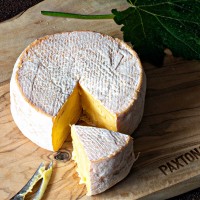We recently caught up with Jake Wigmore, the talented cheese maker behind Village Maid Cheese. From the rich flavours of Wigmore cheese to the creamy taste of Waterloo and the funky flavours of Maida Vale, Jake's cheeses are a testament to his passion and skill. Read on as we uncover the story behind Jake's journey and his latest venture into the world of blue cheeses with Barkham Blue.
How did you get into cheese making?
We moved from our first dairy in Spencers Wood (where Spenwood got it’s name) to Riseley in 1991 when I was 6 months old. At the time, what would become the dairy was just a barn that was being used as a Harley Davidson workshop! Anne & Andy (mum & dad) converted this into a dairy with help from my grandparents and this served as our cheesemaking facility for almost 20 years. I worked at the dairy on and off throughout my teenage years - during school holidays and in the summers between university years. After uni I worked in various advertising agencies in London, which was when I met my wife, Kayleigh, and we both decided to escape the city for a more rural life and joined the family business in May 2017.
Why did Village Maid Cheese decide to make a soft ewe's milk cheese such as Wigmore, as opposed to other types of cheese?
Anne had been supplying Neal’s Yard Dairy with Spenwood and a conversation with Randolph Hodgson led to the question, what if we used the sheep milk to make a bloomy rinded cheese? French imports such as Camembert and Brie were gaining popularity in the UK, so mum decided to go about making a sheep’s milk alternative!

Describe a typical day at Village Maid Dairy.
Our milk delivery comes in around 6am (alternates daily between cow and sheep) and the milk gets thermised before cultures are added and the milk is brought up to renneting temperature. The previous day’s make comes out of the moulds and goes into the brine tanks and then it’s a big clean-up operation before the new make begins. In the maturing rooms, cheeses are being turned, washed and since introducing Barkham Blue to our range, pierced! In the packing room thousands of cheeses are being hand-wrapped by our wrapping team and packed up for wholesale collections. Two Cheesemakers independently run two vats and take the initial steps to make the day’s cheese, until around 11am when filling begins and the Dairy Assistants join in the make to get the curds into the moulds. Then it’s another big clean up operation, the brine tanks are made up for the following day and a break for lunch before various afternoon jobs around the dairy commence.
How would you describe your Wigmore cheese to someone who has never tried it before?
Delicate, floral, nutty and unctuous. People often compare it to vanilla ice cream, which is an odd comparison but I can see where they are coming from!
How do you choose to enjoy Wigmore?
I love Wigmore with sparkling wine or Champagne, but it also goes really well with Viognier. It pairs beautifully with sweet fruits, we often serve the cheese with a fig paste and fresh strawberries (particularly great in the summer).
How did you start making Barkham Blue?
Sandy is my mum’s (Anne) cousin and they sold their business to us in February this year after deciding to retire from cheesemaking. As we have used the same Guernsey milk supplier (Laceys Family Farm in High Wycombe) for 20 years it was an easy decision to take the business on, keeping it in the family and keeping this great cheese, Barkham Blue, in production from the same milk it has always been made from.
We are currently turning 1600 litres of Guernsey milk into Barkham Blue one day per week in our existing dairy, whilst construction gets underway for our new, purpose built blue cheese dairy (next door). We hope this will be completed by Autumn 2024 at which time we will move the Barkham Blue production into the new dairy and increase production three-fold.
The process has remained unchanged from how Two Hoots made the cheese - using vegetarian rennet and pasteurised milk. The only slight change is that we have increased the weight of each wheel from approx 700g to 1kg however they are the same ammonite shape. The day after the make, the cheeses are brined (in separate brine tanks to our other cheeses - VERY important!) before drying off and heading to the piercer the following day. After the piercing, they go into our blue maturing room for around 5 weeks before being wrapped, chilled and sold two weeks later.








